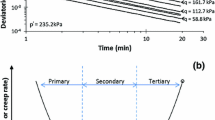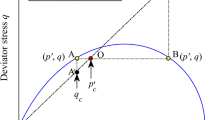Abstract
Aging- or creep-related phenomena in sand have been widely studied, and the discrete element method (DEM) has been frequently used to model the associated soil behavior and then to explore the associated underlying mechanisms. However, several difficulties involved in modeling still remain unsolved. To resolve these difficulties, a new approach based on the effect of the microfracturing of asperities is proposed in this study for the DEM modeling of the sand aging or creep process through several aging cycles of associated reduction in the mobilized friction resistance at particle contacts and subsequent particle rearrangement to reach a new equilibrium state. This approach can be easily incorporated into different contact models and DEM simulations of the loading, unloading, and/or reloading processes, in either drained or undrained conditions, before and/or after aging. This new approach is proven effective because the DEM simulations incorporated with this new approach can satisfactorily reproduce the experimental observations in the triaxial creep process, drained and undrained recompression after aging, and 1D secondary compression and rebound. The simulation results also indicate that, based on the stress–force–fabric relationship, the contribution from the contact normal anisotropy to the deviatoric stress q gradually increases, whereas the contribution from the tangential force anisotropy becomes less during triaxial creep under a constant q. Moreover, the contacts between particles are gradually away from the state where the frictional resistance is fully mobilized, and then become more stable. During the subsequent triaxial recompression after creep, the aged samples exhibit enhanced soil stiffness, which is also found to be associated with the evolution of the invariants of the anisotropy tensors. It is worthwhile noting that the aging or creep effects on the microstructural changes, e.g., the invariants of the anisotropy tensors, can be gradually erased upon further recompression. This explains why the stress–strain responses of the aged samples during recompression gradually rejoin the original stress–strain response obtained from the sample without being subjected to aging or creep.















Similar content being viewed by others
References
Augustesen A, Liingaard M, Lade PV (2004) Evaluation of time-dependent behavior of soils. Int J Geomech 4(3):137–156
Ben-David O, Cohen G, Fineberg J (2010) The dynamics of the onset of frictional slip. Science 330(6001):211–214
Bowman ET, Soga K (2003) Creep, ageing and microstructural change in dense granular materials. Soils Found 43(4):107–117
Brzesowsky R, Hangx S, Brantut N, Spiers C (2014) Compaction creep of sands due to time-dependent grain failure: effects of chemical environment, applied stress, and grain size. J Geophys Res Solid Earth 119(10):7521–7541
Cavarretta I, Coop M, O’Sullivan C (2010) The influence of particle characteristics on the behavior of coarse grained soil. Géotechnique 60(6):413–423
Chantawarungal K (1993) Numerical simulations of three dimensional granular assemblies. Ph.D. thesis, University of Waterloo, Ontario, Canada
Chester JS, Lenz SC, Chester FM, Lang RA (2004) Mechanisms of compaction of quartz sand at diagenetic conditions. Earth Planet Sci Lett 220(3):435–451
Collop AC, McDowell GR, Lee YW (2006) Modelling dilation in an idealised asphalt mixture using discrete element modelling. Granul Matter 8(3–4):175–184
Daramola O (1980) Effect of consolidation age on stiffness of sand. Géotechnique 30(2):213–216
Dieterich JH, Kilgore BD (1994) Direct observation of frictional contacts: new insights for state-dependent properties. Pure Appl Geophys 143(1–3):283–302
Dieterich JH, Kilgore BD (1996) Imaging surface contacts: power law contact distributions and contact stresses in quartz, calcite, glass and acrylic plastic. Tectonophysics 256(1–4):219–239
Fischer-Cripps AC (2004) A simple phenomenological approach to nanoindentation creep. Mater Sci Eng A Struct 385(1):74–82
Gao Y, Wang YH (2016) Experimental characterization of deformation, coefficient of earth pressure at rest, stiffness, and contact force distributions of sand during secondary compression and rebound. Can Geotech J 53(5):889–898
Gao Y, Wang YH, Su JC (2013) Mechanisms of aging-induced modulus changes in sand under isotropic and anisotropic loading. J Geotech Geoenviron Eng 139(3):470–482
Guo N, Zhao J (2013) The signature of shear-induced anisotropy in granular media. Comput Geotech 47:1–15
Howie JA, Shozen T, Vaid YP (2002) Effect of ageing on stiffness of very loose sand. Can Geotech J 39(1):149–156
Human CA (1992) Time dependent property changes of freshly deposited or densified sands. Ph.D. thesis, University of California at Berkeley, Berkeley
Ibraim E, Di Benedetto H, Doanh T (2009) Time-dependent behaviour and static liquefaction phenomenon of sand. Geotech Geol Eng 27(1):181–191
Imole OI, Wojtkowski M, Magnanimo V, Luding S (2014) Micro-macro correlations and anisotropy in granular assemblies under uniaxial loading and unloading. Phys Rev E 89(4):042210
Kanatani K (1984) Distribution of directional data and fabric tensors. Int J Eng Sci 22(2):149–164
Karimpour H, Lade PV (2013) Creep behavior in Virginia Beach sand. Can Geotech J 50(11):1159–1178
Klotz EU, Coop MR (2001) An investigation of the effect of soil state on the capacity of driven piles in sands. Géotechnique 51(9):733–751
Klotz EU, Coop MR (2002) On the identification of critical state lines for sands. Geotech Test J 25(3):1–14
Kuhn MR, Mitchell JK (1992) Modelling of soil creep with the discrete element method. Eng Comput 9(2):277–287
Kuhn MR, Mitchell JK (1993) New perspectives on soil creep. J Geotech Eng 119(3):507–524
Kuhn MR, Renken HE, Mixsell AD, Kramer SL (2014) Investigation of cyclic liquefaction with discrete element simulations. J Geotech Geoenviron Eng 140(12):04014075
Kuwano R, Jardine RJ (2002) On measuring creep behaviour in granular materials through triaxial testing. Can Geotech J 39(5):1061–1074
Kwok CY, Bolton MD (2010) DEM simulations of thermally activated creep in soils. Géotechnique 60(6):425–433
Lade PV, Karimpour H (2010) Static fatigue controls particle crushing and time effects in granular materials. Soils Found 50(5):573–583
Lade PV, Liggio CD Jr, Nam J (2009) Strain rate, creep and stress drop-creep experiments on crushed coral sand. J Geotech Geoenviron Eng 135(7):941–953
Lade PV, Liu CT (1998) Experimental study of drained creep behavior of sand. J Eng Mech 124(8):912–920
Lade PV, Nam J, Liggio CD Jr (2010) Effects of particle crushing in stress drop-relaxation experiments on crushed coral sand. J Geotech Geoenviron Eng 136(3):500–509
Li X (2006) Micro-scale investigation on the quasi-static behavior of granular material. Ph.D. thesis for Civil Engineering, Hong Kong University of Science and Technology, Hong Kong
Ma G, Zhou W, Ng TT, Cheng YG, Chang XL (2015) Microscopic modeling of the creep behavior of rockfills with a delayed particle breakage model. Acta Geotech 10(4):481–496
McDowell G, Khan J (2003) Creep of granular materials. Granular Matter 5(3):115–120
Mesri G, Vardhanabhuti B (2009) Compression of granular materials. Can Geotech J 46(4):369–392
Michalowski RL, Nadukuru SS (2012) Static fatigue, time effects, and delayed increase in penetration resistance after dynamic compaction of sands. J Geotech Geoenviron Eng 138(5):564–574
Mitchell JK, Soga K (2005) Fundamentals of soil behavior, 3rd edn. Wiley, New York
Murayama S, Michihiro K, Sakagami T (1984) Creep characteristics of sand. Soils Found 24(5):1–15
Nadukuru SS, Michalowski RL (2014) Static fatigue at grain contacts: a key cause of time effects in sand. In: Geo-congress 2014, pp 731–740
Ng TT, Dobry R (1994) Numerical simulations of monotonic and cyclic loading of granular soil. J Geotech Eng 120(2):388–403
Oda M (1982) Fabric tensor for discontinuous geological materials. Soils Found 22(4):96–108
Ouadfel H, Rothenburg L (2001) ‘Stress–force–fabric’ relationship for assemblies of ellipsoids. Mech Mater 33:201–221
Persson BNJ (2000) Sliding friction: physical principles and applications. Springer, Berlin
Rothenburg L, Bathurst RJ (1989) Analytical study of induced anisotropy in idealized granular materials. Geotechnique 39(4):601–614
Rubinstein SM, Cohen G, Fineberg J (2004) Detachment fronts and the onset of dynamic friction. Nature 430(7003):1005–1009
Rubinstein SM, Gohen G, Fineberg J (2009) Visualizing stick–slip: experimental observations of processes governing the nucleation of frictional sliding. J Phys D Appl Phys 42(21):214016
Satake M (1978) Constitution of mechanics of granular materials through the graph theory. In: Continuum mechanical and statistical approaches in the mechanics of granular materials, pp 47–62
Schmertmann JH (1991) The mechanical aging of soils. J. Geotech Eng 117(9):1288–1330
Sitharam TG, Vinod JS, Ravishankar BV (2009) Post-liquefaction undrained monotonic behaviour of sands: experiments and DEM simulations. Géotechnique 59(9):739–749
Soroush A, Ferdowsi B (2011) Three dimensional discrete element modeling of granular media under cyclic constant volume loading: a micromechanical perspective. Powder Technol 212(1):1–16
Stegall DE, Mamun MA, Crawford B, Elmustafa AA (2014) Repeated load relaxation testing of pure polycrystalline nickel at room temperature using nanoindentation. Appl Phys Lett 104(4):041902
Suarez NR (2012) Micromechanical aspects of aging in granular soils. Ph.D. thesis, Virginia Polytechnic Institute and State University, Blacksburg
Svetlizky I, Fineberg J (2014) Classical shear cracks drive the onset of dry frictional motion. Nature 509(7499):205–208
Wang YH, Gao Y (2013) Mechanisms of aging-induced modulus changes in sand with inherent fabric anisotropy. J Geotech Geoenviron Eng 139(9):1590–1603
Wang YH, Lau YM, Gao Y (2014) Examining the mechanisms of sand creep using DEM simulations. Granul Matter 16(5):733–750
Wang YH, Tsui KY (2009) Experimental characterization of dynamic property changes in aged sands. J Geotech Goenviron Eng 135(2):259–270
Wang YH, Xu D, Tsui KY (2008) Discrete element modeling of contact creep and aging in sand. J Geotech Geoenviron Eng 134(9):1407–1411
Wang YM, Hamza AV, Ma E (2006) Temperature-dependent strain rate sensitivity and activation volume of nanocrystalline Ni. Acta Mater 54(10):2715–2726
Wang Z, Michalowski RL (2015) Contact fatigue in silica sand—observations and modeling. Geomech Energy Environ 4:88–99
Yimsiri S, Soga K (2010) DEM analysis of soil fabric effects on behaviour of sand. Geotechnique 60(6):483–495
Zhang Z, Wang YH (2015) Three-dimensional DEM simulations on monotonic jacking in sand. Granul Matter 17(3):359–376
Zhang Z, Wang YH (2015b) Examining the initiation mechanisms of static and dynamic liquefaction using three dimensional DEM simulations. In: Proceedings of 5th international conference on computational methods in structural dynamics and earthquake engineering (COMPDYN 2015), Crete Island, Greece
Zhao J, Guo N (2014) Rotational resistance and shear-induced anisotropy in granular media. Acta Mech Solida Sin 27(1):1–14
Acknowledgments
This research was conducted at the HKUST and supported by the Hong Kong Research Grants Council (HKUST6/CRF/12R). The authors are grateful to the reviewers for their valuable comments.
Author information
Authors and Affiliations
Corresponding author
Rights and permissions
About this article
Cite this article
Zhang, Z., Wang, YH. DEM modeling of aging or creep in sand based on the effects of microfracturing of asperities and evolution of microstructural anisotropy during triaxial creep. Acta Geotech. 11, 1303–1320 (2016). https://doi.org/10.1007/s11440-016-0483-3
Received:
Accepted:
Published:
Issue Date:
DOI: https://doi.org/10.1007/s11440-016-0483-3




